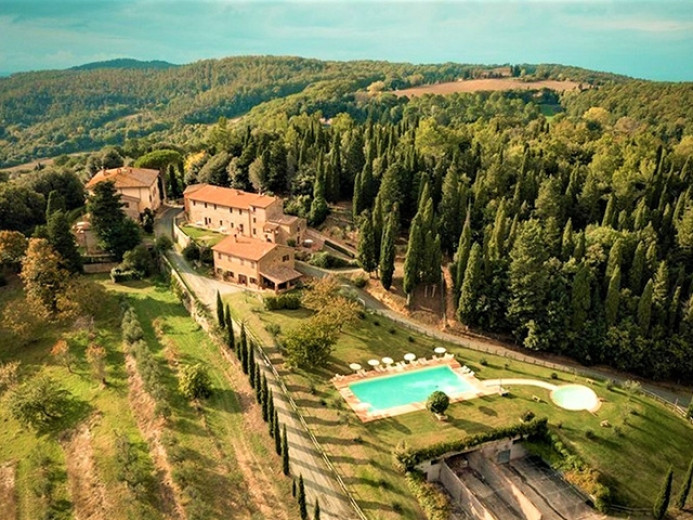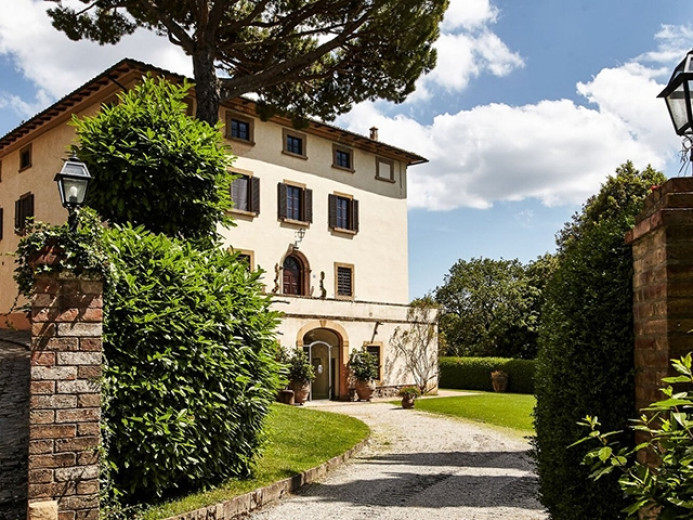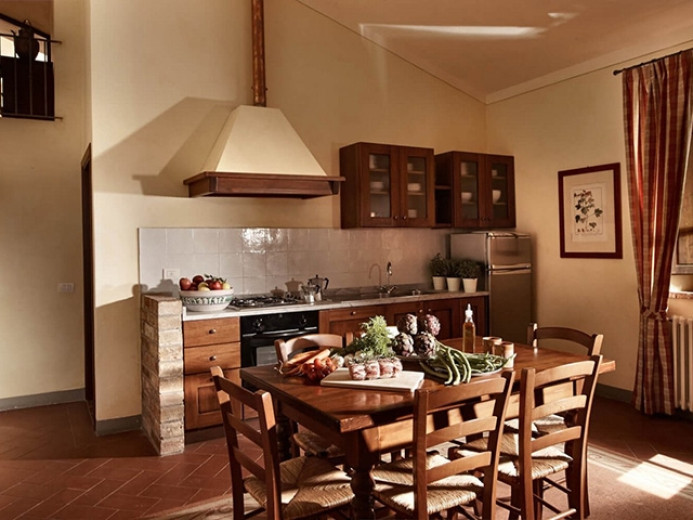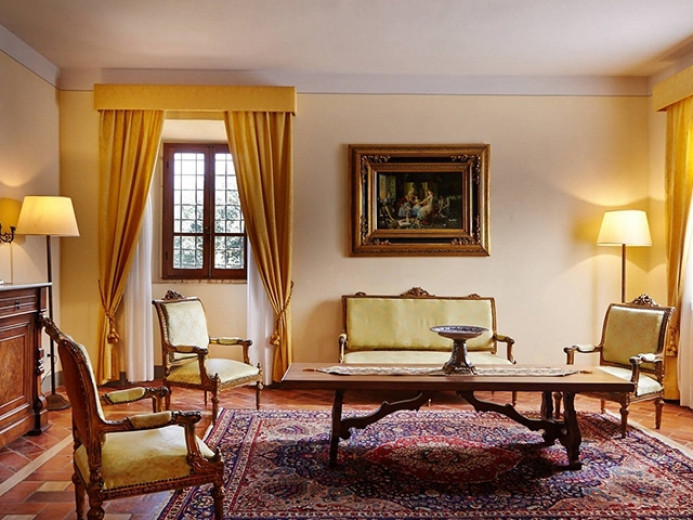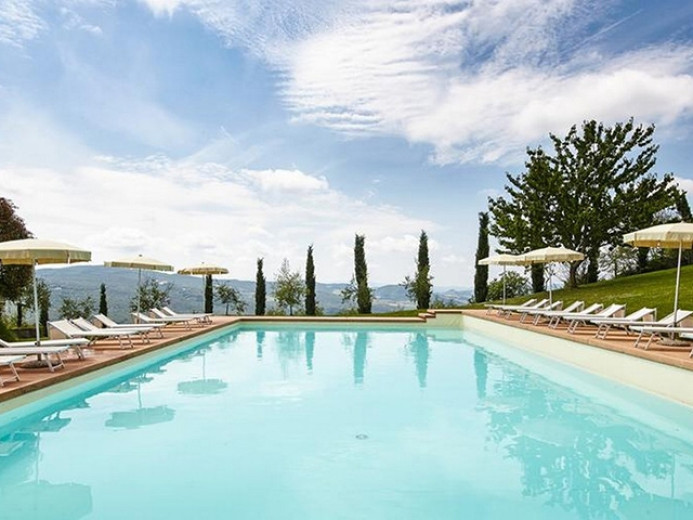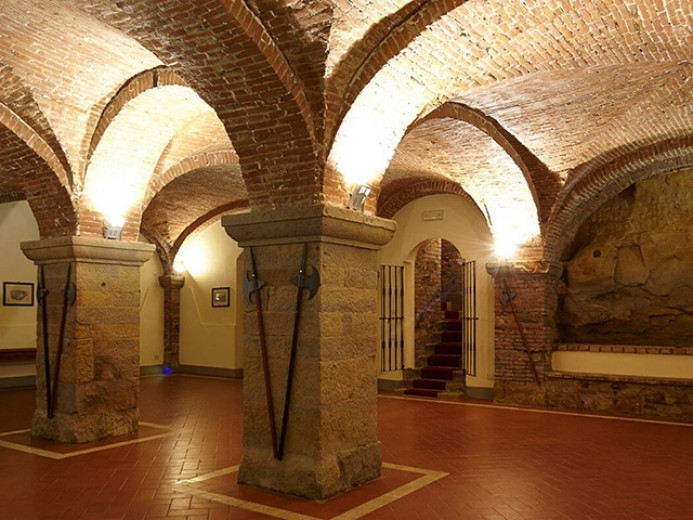Villa in vendita a San Gimignano, 52 locali, 4200 m2
Prezzo su richiesta
Dettagli
Locali
52 locali
Zona giorno
4200 m2
Superficie des terreno
120000 m2
Numero di piani
4 piani
Piano
Piano terra
Ambiente
Villaggio
Parcheggio
All'aperto
Anno di costruzione
1600
Disponibilità
Su richiesta
Prezzo
Prezzo
Prezzo su richiesta
Condizione
Condizione interna
Ottima condizione
Condizione esterna
Ottima condizione
Parcheggio
Parcheggio esterno
Descrizione
The Villa was built in 1600 by the senatorial Rinuccini family of Florence, both to live in during the warmer months of the year and for the administration of the estates they had acquired. Currently the main building, with an adjoining secondary body, houses 4 units for a surface of about 1,600 square meters located in a panoramic position that frames the small rural village that surrounds it. The rooms respect the style of the Tuscan aristocratic residences, spacious and bright living rooms with original terracotta floors and coffered or vaulted ceilings. The villa is internally divided as follows: Ground floor: 2 living rooms, 1 dining room, 1 kitchen, 1 bathroom and other services available. 1st floor : 8 double bedrooms and 8 bathrooms. 2nd Floor : Attic used as storage room. Basement: Reception hall with cross vaults and 2 bathrooms. Outdoor spaces: Garden, secular park and private swimming pool (10 x 6 m). Inside the Borgo there are another 15 flats arranged in 5 farmhouses with typical Tuscan architecture, a reception room with technical rooms and a shed in support of the natural hunting reserve overlooking the hills of Volterra. The property is completed by three swimming pools serving the Villa and the farmhouses and two lakes, the largest of about 8,000 sqm and the other of about 1,000 sqm with beautiful water lilies.
San Gimignano, a historical town in Tuscany, has its origins in 63 B.C. when two young Roman patricians, fleeing from Rome, built the castle of Silvia in Val D'Elsa, around which the town developed.
The town experienced its most flourishing period in the Middle Ages, thanks to the fact that it was crossed by the Via Francigena, one of the main communication routes of the time. In fact, San Gimignano soon became a point of reference for numerous traders, travellers and pilgrims. Involved, then, in the struggles between the Guelphs and Ghibellines, the town resisted every kind of adversity, managing to become considerably richer and seeing in 1200 the year of its greatest economic development. With a historical centre characterised by medieval architecture, San Gimignano is famous above all for the seventy towers built by the richest families of the time, of which fourteen still exist and which characterise the town centre, standing out against the suggestive panorama of the endless green Tuscan hills dotted with vineyards and olive groves. A small pearl of the Sienese province, this village, declared a UNESCO World Heritage Site in 1990, offers, in addition to its history and culture expressed by its monuments, excellent local products such as saffron and Vernaccia di San Gimignano, an excellent local white wine.
La Villa a été construite en 1600 par la famille sénatoriale Rinuccini de Florence, à la fois pour y vivre pendant les mois les plus chauds de l'année, et pour l'administration des biens qu'il avait achetés. Actuellement, le bâtiment principal, avec un corps secondaire adjacent, abrite 4 unités pour une superficie d'environ 1 600 mètres carrés dans une position panoramique dans le petit village rural qui l'entoure. Les chambres respectent le style des résidences aristocratiques toscanes, des salons spacieux et lumineux avec des sols originaux en terre cuite et des plafonds à caissons ou voûtés. La villa est divisée intérieurement comme suit : Rez-de-chaussée : 2 salons, 1 salle à manger, 1 cuisine, 1 salle de bain et autres services disponibles. 1er étage : 8 chambres doubles et 8 salles de bain. 2ème étage : Grenier utilisé comme pièce de stockage. Sous-sol : Hall de réception avec voûtes croisées et 2 salles de bain. Espaces extérieurs : Jardin, parc séculaire et piscine privée (10 x 6 m). À l'intérieur du Borgo se trouvent 15 autres appartements répartis dans 5 maisons à l'architecture typiquement toscane, une salle de réception avec des locaux techniques et un hangar à l'appui de la réserve naturelle de chasse surplombant les collines de Volterra. La propriété comprend trois piscines desservant la villa et les maisons et deux lacs, le plus grand d'environ 8 000 mètres carrés et l'autre d'environ 1 000 mètres carrés avec de magnifiques nénuphars.
San Gimignano, ville historique de Toscane, trouve ses origines en 63 avant J.-C. lorsque deux jeunes patriciens romains, fuyant Rome, ont construit le château de Silvia dans la Val D'Elsa, autour duquel le village s'est développé.
La ville a connu sa période la plus florissante au Moyen Âge, grâce au fait qu'elle était traversée par la Via Francigena, l'une des principales voies de communication de l'époque. En fait, San Gimignano est rapidement devenu un point de référence pour de nombreux commerçants, voyageurs et pèlerins. Impliquée, donc, dans les luttes entre les Guelfes et les Gibelins, la ville résiste à toutes sortes d'adversités et parvient à s'enrichir de plus en plus, voyant en 1200 l'année de son plus grand développement économique. Avec un centre historique caractérisé par une architecture médiévale, San Gimignano est surtout célèbre pour les soixante-dix tours construites par les familles les plus riches de l'époque et dont il reste quatorze qui caractérisent le centre ville se détachant sur le paysage pittoresque des collines toscanes vertes et infinies parsemées de vignobles et d'oliveraies. Petite perle de la province de Sienne, ce village déclaré patrimoine mondial de l'UNESCO en 1990 offre, outre son histoire et sa culture exprimées par les monuments, d'excellents produits locaux comme le safran et le Vernaccia di San Gimignano, un excellent vin blanc local.
Die Villa wurde im Jahre 1600 von der Senatorenfamilie Rinuccini aus Florenz erbaut, sowohl um dort während der wärmeren Monate des Jahres zu wohnen, als auch für die Verwaltung der Besitztümer, die er erworben hatte. Derzeit beherbergt das Hauptgebäude mit einem angrenzenden Nebenbaukörper 4 Einheiten auf einer Fläche von ca. 1.600 Quadratmetern in Panoramalage in dem kleinen ländlichen Dorf, das es umgibt. Die Zimmer respektieren den Stil der toskanischen Aristokratenresidenzen, geräumige und helle Wohnräume mit originalen Terrakottaböden und Kassetten- oder Gewölbedecken. Die Villa ist im Inneren wie folgt aufgeteilt: Erdgeschoss: 2 Wohnzimmer, 1 Esszimmer, 1 Küche, 1 Badezimmer und andere Dienstleistungen zur Verfügung. 1. Stock: 8 Doppelschlafzimmer und 8 Badezimmer. 2. Stock: Dachboden als Abstellraum genutzt. Untergeschoss: Empfangshalle mit Kreuzgewölbe und 2 Bädern. Außenanlagen: Garten, jahrhundertealter Park und Privatschwimmbad (10 x 6 m). Im Inneren des Borgo befinden sich weitere 15 Wohnungen, die auf 5 Häuser mit typisch toskanischer Architektur verteilt sind, ein Empfangsraum mit technischen Räumen und ein Schuppen zur Unterstützung des natürlichen Jagdreservats mit Blick auf die Hügel von Volterra. Zum Anwesen gehören drei Swimmingpools, die der Villa und den Häusern dienen, und zwei Seen, der größte von ca. 8.000 Quadratmetern und der andere von ca. 1.000 Quadratmetern mit wunderschönen Seerosen.
San Gimignano, eine historische Stadt in der Toskana, hat ihre Ursprünge im Jahr 63 v. Chr., als zwei junge römische Patrizier auf der Flucht vor Rom die Burg Silvia im Val D'Elsa errichteten, um die sich der Ort entwickelte.
Die Stadt erlebte ihre größte Blütezeit im Mittelalter, dank der Tatsache, dass sie von der Via Francigena durchquert wurde, einer der wichtigsten Kommunikationsrouten jener Zeit. In der Tat wurde San Gimignano bald zu einem Bezugspunkt für zahlreiche Händler, Wanderer und Pilger. In die Kämpfe zwischen den Guelfen und den Ghibellinen verwickelt, widerstand die Stadt allen Widrigkeiten und schaffte es, immer reicher zu werden und sah im Jahr 1200 das Jahr ihrer größten wirtschaftlichen Entwicklung. Mit einem historischen Zentrum, das sich durch eine mittelalterliche Architektur auszeichnet, ist San Gimignano vor allem für die siebzig Türme berühmt, die von den reichsten Familien der Zeit erbaut wurden und von denen es noch vierzehn gibt, die das Stadtzentrum charakterisieren, das sich von der malerischen Landschaft der endlosen grünen toskanischen Hügel, die mit Weinbergen und Olivenhainen übersät sind, abhebt. Die kleine Perle der Provinz Siena, die 1990 von der UNESCO zum Weltkulturerbe erklärt wurde, bietet neben ihrer Geschichte und Kultur, die in den Monumenten zum Ausdruck kommt, auch hervorragende lokale Produkte wie Safran und Vernaccia di San Gimignano, einen ausgezeichneten lokalen Weißwein.
La Villa venne costruita nel 1600 dalla famiglia senatoria dei Rinuccini di Firenze, sia per abitarvi nei mesi più caldi dell’anno, sia per l’amministrazione dei possessi che aveva acquistati. Attualmente l’edificio principale, con un corpo secondario adiacente, ospita 4 unità immobiliari per una superficie di circa 1.600 mq posti in posizione panoramica a cornice del piccolo borgo rurale che la circonda. Gli ambienti rispettano lo stile delle dimore gentilizie toscane, ampi e luminosi saloni con originali pavimenti in cotto e soffitti a cassettone o ad volta. La villa internamente è così suddivisa: Piano terra : 2 soggiorni, 1 sala da pranzo, 1 cucina, 1 bagno e altri servizi a disposizione. 1° Piano : 8 camere da letto matrimoniali e 8 bagni. 2° Piano : Mansarda adibita a ripostiglio. Seminterrato: Salone di ricevimenti con volte a crociera e 2 bagni. Spazi esterni: Giardino, Parco secolare e Piscina privata (10 x 6 m). All'interno del Borgo trovano posto altri 15 appartamenti disposti su 5 casali dalle tipiche architetture toscane, un locale reception con vani tecnici ed una rimessa a corredo della riserva naturale di caccia affacciata sulle colline di Volterra. Completano la proprietà tre piscine a servizio della Villa e dei casali e due laghi, il più grande di circa 8.000 mq e l’altro di circa 1.000 mq con bellissime ninfee.
San Gimignano, paese storico della Toscana, vede le sue origini nel 63 A.C. quando due giovani patrizi Romani fuggitivi costruirono, in Val D’Elsa, il castello di Silvia attorno al quale si sviluppò, poi, il borgo.
Il paese visse il suo periodo più florido nel Medioevo, grazie al fatto di essere attraversato dalla Via Francigena, una delle principali vie di comunicazione dell’epoca. Infatti, San Gimignano diventò ben presto punto di riferimento per numerosi commercianti, viandanti e fedeli in pellegrinaggio. Coinvolto, poi, nelle lotte tra Guelfi e Ghibellini il paese resistette ad ogni tipo di avversità riuscendo ad arricchirsi notevolmente e vedere nel 1200 l’anno del suo maggiore sviluppo economico. Con un centro storico caratterizzato da un’architettura medievale, San Gimignano è famoso soprattutto per le settanta torri costruite dalle famiglie più ricche dell’epoca e delle quali ne esistono ancora quattordici che ne caratterizzano il centro cittadino svettando sul panorama suggestivo delle interminabili e verdeggianti colline toscane costellate di vigneti e oliveti. Piccola perla della provincia Senese, questo borgo dichiarato patrimonio dell’umanità dall’UNESCO nel 1990 offre, oltre alla sua storia e cultura espresse dai monumenti, ottimi prodotti locali come lo zafferano e la Vernaccia di San Gimignano, ottimo vino bianco locale.
Attrezzature
Animali ammessi
Aria condizionata
Balcone
Cantina
Camino
Bella vista
Piscina
Terrazza
Adatto ai bambini
Contattate l'inserzionista
N. Inserzione
pgqe38gm
Rif. inserzionista
4130604
Contattate l'inserzionista
Condividi questa pagina
